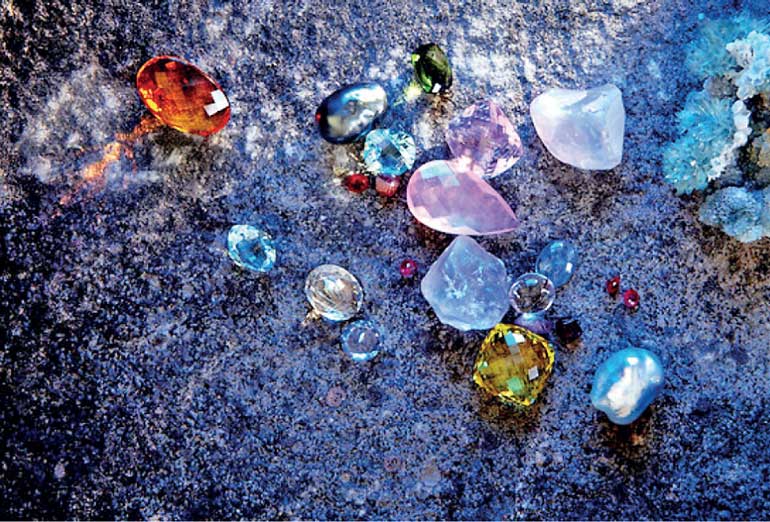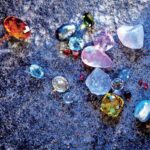Sri Lanka has a glittering history for its owned gems, hence this enchanted island was better known as the “Rathna Deepa” or Gem Island in ancient history. Its mineral-rich soils have been yielding seemingly a never-ending supply of high-quality precious and semi-precious gemstones. Sri Lanka has a rich history of large deposits of diverse gemstones. Ratnapura (‘The City of Gems’ in Singhalese) is very famous for gem mining in Sri Lanka and it has an incredible variety of gemstones, many of them outstanding in comparison with stones from other regions.
Sri Lanka has built its reputation as one of the finest gem cutting and finishing centres in the world, offering gemstones that meet the highest international standards. In the global market, Sri Lanka has made a special identity as the most important source of high-quality sapphires.
History of Gems
According to the legends in Sri Lanka, King Rawana had a tremendous collection of Precious stones 5000 years ago. In the 5th century BC, the Buddha visited Kelaniya, Sri Lanka to stop a war between two Naaga kings called Chulodara & Mahodara over a gem-studded throne. King “Soloman” sent his agents to this island to purchase priceless gemstones when he wanted to win the heart of queen “Sheeba”. Famous travellers such as Iban Batuata, Pahiyan and Marco Polo have mentioned this natural wealth of Sri Lanka in their personal notes. Ptolemy, the 2nd-century astronomer recorded that beryl and sapphire were the mainstays of Sri Lanka’s gem industry. Marco Polo wrote of his visit in 1292: “I want you to understand that the island of Ceylon is, for its size, the finest island in the world, and from its streams comes rubies, sapphires, topazes, amethyst, and garnet.”.
Furthermore, the records from the sailors of the Middle East and Persian traders who visited the island wrote that they brought back the jewels of Serendib in the 4th & 5th century AD. Robert Knox gives a fine account of gem mines owned by the king in his book.
Gem Mining Areas

The Ratnapura region was the first locality to mine sapphires on the island. Significant gem mines throughout Sri Lanka are the Bible sapphire mines (central), Elehara Gem Fields (near Ratnapura), Metiyagoda moonstone mines (south-west coastal), Morawaka (south-central), Nuwara Eliya mines (mountainous tea plantation area), and Pelmadulla sapphire mines (15 km south-east of Ratnapura). Sri Lanka’s Bible area is located in the central-eastern region of the island in the Uva Province. Ceylon-blue sapphire is mined in pits and dug into the rice paddies that carpet the valley floor. Alluvial sapphire deposits are found in gem-bearing river gravels (illam), in ancient flood plains and streams that are now covered with farmland. Sri Lanka’s alluvial Elahera Gem Fields are located in the Matale District near the Wasgomuwa strict natural reserve, in the North Central Province of Sri Lanka; 115 km northeast of Colombo. The Elahera Gem Fields are estimated to produce up to 35% of the gemstones exports from Sri Lanka. The Elahera mines contain a variety of gem-quality minerals including chrysoberyl, garnet, sapphire, spinel, tourmaline, and zircon.

Gem Varieties
Sri Lanka is blessed with over 70 varieties of coloured stones out of the 200 found in the world and is among the five most important gem-bearing nations. The country’s breath-taking natural heritage comprises a variety of gem minerals, which include Blue, Pink, Yellow and Golden Sapphires, Rubies, Padmaradchas, Star Sapphires, Star Rubies, Alexandrite, Cat’s F, Spinel, Aquamarines, Topaz, Zircons, Garnets, Tourmalines, Moonstones, Quartz and a large number of rare gemstones. Sri Lankan Gem Suppliers & Dealers take immense pride in the fact that Sri Lanka is the world’s choice for calibrated and fancy cut gemstones, high-value single stones and quality service cutting.

Blue Sapphire
Sri Lanka has been known for its fabulous high-quality blue sapphires, all over the world. Although African countries like Madagascar, Mozambique and Tanzania are also famous for blue sapphires. But the largest stones can only be found in Sri Lanka. Every possible shade of blue is represented among sapphires of Sri Lanka, the various shades ranging from the palest to the darkest. High-quality blue sapphires from Sri Lanka are reputed for having a pleasing tone of colour of whatever the shades are of remarkable transparency. In superior quality material the Degree of transparency of very high and its clarity is excellent. The most desired coloured and stones for a sapphire have been describing as instance cornflower blue with a “Velvety” lustre. The combination of such features those rare is the pride of Sri Lanka.

Ruby
Corundum of red colour is identified as Rubies. Most Sri Lankan varieties are of a pinkish red and display a tint of purple which factor perhaps is sufficient to betray to the experienced person that the stones are of Sri Lankan origin. These purplish tints are attributed to the presence of iron in addition to chromium oxide in the composition. Such stones when subject to instance heat would either lose or diminish the purplish tint thereby highlighting the principal colour, red. This colour is referred to as “Pigeon Blood Red” in gem circles. As a rule, Ruby deposits as such have not been specifically localized in Sri Lanka and are found in association with other members of the Corundum family. However, as indicated earlier the stones of better quality have been more often than not found within the Embilipitiya – Udawalawe environs.
Padparadscha
The term Padparadscha is a Sinhalese term applied to a very special colour variety of Corundum, so named after the lotus flower as its colour is sometimes akin to a variety of this flower. The Padparadscha has an exceptional colour combination which is very attractive and rare. The colour combination produces the beautiful colour of a sunset at its best as seen across a tropical sky. The colour of Padparadscha is apparently a combination of pink and orange.
Star Sapphires
Star stones of the corundum family are either star sapphires or rubies. When light falls on these stones, a star effect is visible (known as asterism). Sri Lanka is the best-known source for star sapphires and star rubies. Star sapphires range in colour from grey to bluish-grey and from medium blue to medium dark blue. The very slightly purplish medium dark blue is the best colour grade for star sapphires. Star rubies range from light pink-red to purple-red through deep purple-red. The intense red star rubies are extremely rare. A good quality star stone should have a high degree of transparency and a well-defined star with no weak or missing rays. It should be reasonably clean and in the face-up position, no distracting inclusions or cracks should be seen. There should be no excess weight at the bottom of the stone.
Cat’s Eye
Cat’s eye has been observed as a preserver of good fortune. British royalty frequently uses it as an engagement stone. The ideal colours of the chrysoberyl cat’s-eye are yellowish-brown, which is called the honey colour, and yellow-green, which is called the apple green colour. There are two varieties of cat’s eye. The alexandrite cat’s-eye and the chrysoberyl cat’s-eye. Cat’s eye stone is highly suggested for those who do business. It guards the wearers against losses in business and guarantees financial steadiness.
Alexandrite
Alexandrite is a variety of chrysoberyl that is perhaps rarest and Sri Lanka is famous for producing larger stones with fair colour change. The primary beauty of this gem is due to its colour change. At best Sri Lankan stones can be grass green in daylight and violet red to raspberry red in incandescent or artificial light. The gem is priced according to the percentage of colour change found in the stone. Although most alexandrite can be faceted, occasionally there is an unusual colour-changing alexandrite cat’s eye too.
Emerald
The emerald is the hallowed stone of the goddess Venus. The emerald has long been the symbol of hope and love. Ancient records explain that the stone was traded in Babylonian markets as early as 4,000 BC. Because of their green colour, emeralds are linked with reincarnation and spring as well as are said to enhance ingenuity. They moreover unlock the door to new possibilities.
Zircon
Zircon is a zirconium silicate, occurring in colourless, light blue, brownish-orange, yellow, yellowish-green, brownish-green, dark red or light red-violet. Blue is the most valuable. This stone is usually heat-treated.
Moonstone
The moonstone is associated with the moon and was the stone of the goddess Diana. The most powerful time to use the moonstone is on a full moon. It has been worn as an amulet to bring good emotions to the wearer while protecting those of a sensitive nature. It can reunite lovers who have quarrelled. Moonstone is also considered a good luck stone. The most precious of the feldspar gems. Moonstones are typically colourless to white, semi-transparent to translucent, and characterized by a glowing light effect known as adolescence, the visibility of which is limited to a restricted angle of view.
For your kind Cooperation
Any of who gives feedback for this article or any article,
please put your accurate contact details (Whats app or E-mail) to give our valuable feedback. If not we cannot post any feedback on your requirements. Many of you who have posted your valuable feedback for us can’t contact us with the mentioned E-mail Id. So this is a kind request to share with us your accurate contact details



